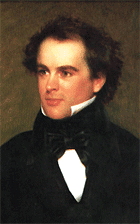Hawthorne

Novelist and short story writer Nathaniel Hawthorne was born on this day in 1804 in Salem, Massachusetts.
One of America's greatest fiction writers, Hawthorne came from an old New England family which had participated in the notorious Salem witch trials in the 17th century, a fact which armed him with a heavy dose of ancestral shame as well as a store of mythically pregnant material for the allegories he would spin. He attended Bowdoin College with Franklin Pierce and Henry Wadsworth Longfellow, but after college lived for 12 years in self-imposed seclusion and virtual "retirement" in his mother's home in Salem, writing occasional sketches for newspapers.
In 1828, he self-published a romance, Fanshawe, then thought better of it and tried to destroy all the copies. During the 1830s he began to find his voice, drawing upon his Salem heritage for a gloomy "witchcraft" tale, "Young Goodman Brown" (1835), and he eventually published a collection of his stories, Twice-Told Tales (1837). After a brief fling at a Transcendentalist utopian experiment known as "Brook Farm," at age 38 he married and settled at the former Concord home of Ralph Waldo Emerson. There he published a second collection of stories, Mosses from an Old Manse (1846), which included his classic misanthropic romance "Rappaccini's Daughter."
With debts beginning to mount, however, Hawthorne moved back to Salem to accept appointment as surveyor to the custom house. The job was short-lived due to political currents, but within a few months of losing his position Hawthorne had written his masterpiece, the novel The Scarlet Letter (1850), a story of obsession and guilt in which only the heroine, the dishonored mother of an illegitmate child, Hester Prynne, emerges as a character of strength and integrity. The book made him famous and economically secure, permitting him to concentrate on two more novels: The House of the Seven Gables (1851, a fictional story of the accursed Pyncheon family, named without malicious intent after the ancestors of novelist Thomas Pynchon; indeed, Hawthorne received a couple of complaint letters from contemporary Pynchons for holding up their good name to "derision and contempt") and The Blithedale Romance (1852, a fictionalized statement of his disenchantment with the Brook Farm experiment).
He wrote a campaign biography for his old friend Franklin Pierce in 1852, and following Pierce's election as president Pierce returned the favor by appointing Hawthorne consul at Liverpool and Manchester (1853-57). He spent a few years traveling in Italy before returning home to publish his final novel, The Marble Faun (1860) and a series of sketches about his stay in England, Our Old Home (1863). He left 4 unfinished novels at the time of his death on May 19, 1864 in Plymouth, New Hampshire.
Without question, The Scarlet Letter is Hawthorne's most often filmed work, being the source of four major films, but we are perhaps still waiting for a definitive version: 1926, directed by Victor Sjostrom with Lillian Gish; 1934, with Colleen Moore; 1972, by Wim Wenders; and 1995, with Demi Moore, Gary Oldman and Robert Duvall.
Labels: Literature, Presidential Campaigns





0 Comments:
Post a Comment
Subscribe to Post Comments [Atom]
<< Home